- This article is about the location in the series. For the location in the film, see Southern Water Tribe.
The Southern Water Tribe is an independent state at the South Pole and the southern division of the Water Tribes. A federation of several smaller tribes,[2][6] the South is ruled by a Council of Elders, who also elect the tribe's chief. The Southern Water Tribe achieved its independence only after the Water Tribe Civil War in 171 AG; before, the tribe had been an autonomous confederation of several smaller tribes under the Northern Water Tribe's jurisdiction.[3][4][6][7] The South is a major economical power, with its people mostly living in its coastal capital and several villages nearby.[1] The people of the Southern Water Tribe are modern, progressive, and focused on commerce and trade, but lack in spirituality.[8]
The Southern Water Tribe had an eventful history and saw times of prosperity and freedom as well as decline and genocide. Before the Hundred Year War, the South was thriving and had a unique culture and waterbending style. After a series of brutal Fire Nation raids, however, the South Pole was left devastated and almost without any waterbenders. By 99 AG, the Southern Water Tribe was on the brink of extinction, with its culture shattered, its main city largely abandoned, and its unique waterbending style effectively erased.[9][10] This changed when Katara and Sokka discovered Avatar Aang in 99 AG and began to travel together with him in order to end the war and save the world.
After this group's involvement in the Siege of the North, the Northern Water Tribe administrated a relief effort led by Master Pakku, who brought along a number of warriors, waterbenders, and healers to aid in the Southern tribe's redevelopment. This mission proved to be successful, resulting in political rapprochement between the two tribes.[11] Nevertheless, after the North began to undermine the South's traditional autonomy,[8] resentment grew among Southern tribesmen that eventually escalated into a civil war that Avatar Korra ended with the South's independence.[4][6][7][12]
History
Foundation and growth
Originally, the Water Tribe existed as one nation, solely based in the North Pole. However, following civil unrest, a large group of warriors, waterbenders, and healers journeyed to the South Pole to engender a new tribe.[10] The Southern Tribesmen eventually agreed to reaccept the Northern chief as their ruler, as long they were granted autonomy and their own government for internal affairs.[3] Despite this political rapprochement, the enormous geographical distance between the two sects caused them to evolve differently. Even though their cultures were still similar, as they maintained common customs and celebrations until 50 AG, the people of the North and South developed completely differently in regard of society and politics. The Southern Water Tribe was far less hierarchical than the North, enjoying a high degree of gender equality. The Southern tribesmen eventually built a massive inland city as their political and cultural center and the tribe began to prosper, even though it never reached the size and importance of the North.[10] During these years, a tradition of celebrating the Glacier Spirits Festival began, during which the people would fast and meditate, and the tribal elders would commune with the spirits as they danced in the sky to create the southern lights; it ended on the day of the winter solstice.[13]
The Southern tribesmen also began to travel around the world. One group of Southern waterbenders discovered the Foggy Swamp in the Earth Kingdom thousands of years before the Hundred Year War. They decided to stay because of the abundant amounts of water there, engendering the Foggy Swamp Tribe in the process. However, as the Foggy Swamp tribesmen maintained isolation, the people of the South Pole never learned of these events. By the beginning of the Great War, the Southern Water Tribe had grown into a strong nation, with its capital filled with hundreds and hundreds of capable waterbenders of both men and women.[9][10]
Raids
- Main article: Southern Water Tribe raids
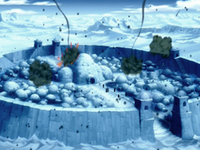
The Fire Nation's first attack.
The Southern Tribe was almost destroyed following attacks from the Fire Nation, which started around forty years into the Hundred Year War. The Fire Nation Navy employed a great number of firebenders and cruisers in order to capture as many waterbenders from the Southern faction as they could. By doing so, the Fire Nation hoped to destroyed all resistance in the South. Despite being outnumbered, the Southern waterbenders and nonbending warriors were able to defend themselves against the raids through fierce resistance, boasting minor victories such as successfully trapping a Fire Nation ship which eventually developed into the shipwreck. However, their determination was not enough and a systematic set of attacks eventually left Hama as the only waterbender left, prior to her eventual surrender.[9] Tribal unity declined following the capture and execution of all of waterbenders, and the central city divided into small conglomerations of tepees and igloos scattered throughout the South Pole.[10]
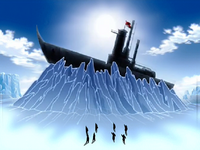
A Fire Nation cruiser was trapped by Southern waterbenders during the raids.
In 94 AG, the Southern Water Tribe was attacked by the Southern Raiders, an elite Fire Nation naval force assigned to raid the South Pole when ordered. They were informed that one waterbender remained in the Southern Water Tribe, and subsequently assigned to eliminate her. Knowing that the remaining waterbender was her eight-year old daughter Katara, Kya gave her life by confessing to Captain Yon Rha that she was in fact the last waterbender. Her death provided the Fire Nation with the impression that the Southern waterbending lineage had been completely eradicated, and left Katara as the sole survivor.[14]
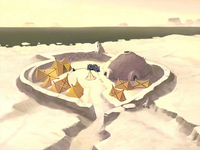
By 99 AG, the Southern Water Tribe's unity was broken, its people spread over a collection of small villages.
In the final years of the Hundred Year War, the Southern Water Tribe was in dire straits and was teetering on the brink of extinction. The land was spiritually unbalanced as well, as the spirit portal it held had been closed up and frozen over.[13]
The Tribe's remaining population was dwindling due to Fire Nation raids and was defenseless, as its warriors had left for the Earth Kingdom to aid them against the Fire Nation. With the departure of the sole remaining waterbender, Katara, and warrior, Sokka, the tribe consisted mostly of elderly, middle-aged women, mothers and very young children.[15] After the Siege of the North, a group of waterbenders and healers from the Northern Tribe were sent to the Southern Tribe to help rebuild their sister tribe.[16]
After the Hundred Year War
Following the creation of the United Republic, the Southern Water Tribe was given a seat on the United Republic Council, charging one of its residents with helping to oversee the sovereign state.[17] Some of the tribe's citizens also emigrated to the United Republic over the years, where a cultural center was built for them in the capital itself.
From the end of the war to before 153 AG, the South underwent extreme physical changes. People from the Northern Water Tribe came down and begun working on physically rebuilding the South and returning it to its former glory, although its spiritual balance remained tipped. The land was greatly expanded, so much so that large compounds were made as well as full cities. The tribe was physically returned to its former glory.[18]
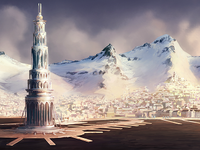
The rebuilt Southern Water Tribe in 171 AG.
In 153 AG, the next Avatar in the cycle, Korra, was born in the Southern Water Tribe. A large compound was built for her to train in waterbending, earthbending and firebending, as well as with the Order of the White Lotus. At the age of seventeen, Avatar Korra left the compound and the Southern Water Tribe.
Following the Anti-bending Revolution, Avatar Korra traveled to the Southern Water Tribe, as did Unalaq, chief of the Water Tribes at the time. There, she ceased training under Tenzin, and began training in spirituality under Unalaq, who instructed her to enter the Everstorm with him. Upon arriving at the Everstorm, Avatar Korra opened the spirit portal allowing the Southern sky to be lit up with dancing spirits once more.[13]
Civil unrest
After the spirit portal was opened, Chief Unalaq summoned his forces to the tribe, in an abrasive attempt to unite the North and the South. Unrest ensued between Unalaq's forces and the Southern population, and soon talks of a rebellion began.
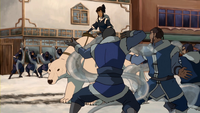
Southern Water Tribe civilians threatening to attack Northern Water Tribe soldiers.
An attempt on Unalaq's life was made by rebels, however, Avatar Korra thwarted the plot as it was being carried out. Unalaq commanded that the rebels be thrown in prison forever, but Korra successfully convinced him to allow them to stand trial, as she thought it would appease the South. However, Unalaq suspected Korra's parents, Tonraq and Senna, of being part of the attempted assassination and ordered them arrested.[6] The accused were brought before Judge Hotah, who acquitted Senna but sentenced the others to life imprisonment. Korra later confronted Hotah and learned that the entire trial was a sham orchestrated by Unalaq. Thus, she and her friends busted her father and the rebels out of prison, officially igniting a civil war between the Water Tribes.[5]
The Southern Water Tribe ultimately won its independence when the Avatar defeated Unalaq and the Northern forces peacefully returned home, though both tribes would remain allies. The Southern Council of Elders soon elected Tonraq as their tribe's new chief.[4]
Government
Government system: Federal[2] parliamentary[3] elected chiefdom[4] (formerly confederate chiefdom)
Head of State: Tribal chief
Head of Government: Chairman of the Council of Chieftains and Elders
Originally, the individual villages of the Southern Water Tribe were each led by a single leader, or chief. By 100 AG, these roles were restricted to male warriors; Hakoda led the southernmost tribe in 100 AG, for instance.[2] During this time, the Southern Water Tribe was a much smaller and less stratified society, unlike its Northern counterpart.

Years later, the Southern Water Tribe accepted the authority of the Northern Water Tribe Chiefdom, but retained autonomy. A Council of Chieftains and Elders officially govern the Southern Water Tribe, consisting of male and female representatives of the different cities, villages, tribes, and social classes within the settlements. The council assembles in the Southern Water Tribe Royal Palace, which serves as the formal seat of government in the South Pole. Traditionally residing in the North, the tribal chief does not hold much more than a figurehead position to the Southerners; his primary duties involve ceremonial and representative tasks.[6][7]
In times of crisis, nevertheless, the Chief of the Northern Water Tribe can take a much stronger hold on the Southern Water Tribe's functions. Northern intervention, however, is not well received in the South, as was evident when a blight involving dark spirits prompted Chief Unalaq to intervene in the Southern Water Tribe's affairs. Many tribesmen saw Unalaq and his forces as oppressors, demonstrating the strong spirit of independence in the South.[12]
Citizens of the Southern Water Tribe who commit a crime have the right to a trial prior to being incarcerated. The following tribunals are held in a courtroom located inside the royal palace, where a single jurist oversees the court proceedings.[6]
After the Water Tribe Civil War, Avatar Korra declared the war over, and the Southern Water Tribe an independent state. The chieftains elected the Avatar's father, Tonraq, to be their next chief.[4]
Locations
Harbor City
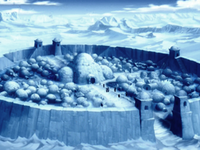
The old inland capital in 40 AG. After being almost destroyed during the Hundred Year War, it was later rebuilt and evolved into the harbor city.
The old capital of the Southern Water Tribe, positioned on a northern shoreline, was a large inland city by 40 AG, and consisted of dozens of tents and igloos surrounded by a very large ice wall. A central igloo lay in the center of the village, which was circular in design. However, the capital shrunk in size due to constant raids by the Fire Nation and the departure of the Water Tribe warriors.[9]
Toward the end of the Hundred Year War, the capital had been reduced to a tiny village, was surrounded by a low, roughly circular snow wall, broken up by a snow watchtower, which was built by Sokka, to the north and a non-gated entrance to the south. Inside were eight residential tents, arranged semi circularly around a communal fire pit. A giant igloo hugged the east wall, while a handful of smaller units clustered the north wall. Outside, to the right of the entrance, was a small igloo structure that served as the village outhouse. The remaining population stood at less than two dozen, with ten older women, ten young children and one domesticated polar dog.[19]
In the years after the end of the Hundred Year War, the capital grew considerably, showing the success of the Northern Water Tribe volunteers who helped rebuild the Southern Water Tribe during the time of Avatar Aang. By 171 AG, the once small capital had grown into a large, modern city, and a harbor had been built at the edge of the city for ships to dock.[13]
The shipwreck
- Main article: Shipwreck
West of the village lies a Fire Navy ship, torn open by jutting ice shelves. Though the shipwreck is a relic of the Fire Nation's historic first strike, its booby traps are still in working order. Aang accidentally set off a flare that was meant to signal the Fire Nation.[19] It is later revealed that Hama and the Southern waterbenders were responsible for the wrecking of the vessel, as a brief scene shows them raising the ship up with ice and grounding it.[9] The location appears to be the same seen when Aang and Katara explored it.[19]
Compound
- Main article: Southern Water Tribe compound
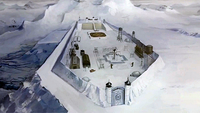
The Southern Water Tribe compound lies deep within the South Pole. It is a small, isolated encampment secured by thick ice walls and a large gate. The enclosure features several watchtowers, large buildings for shelter, an obstacle course and sub-level pens lined with hay for fauna, such as Naga. A large raised platform made of ice is located in the center of the camp, both for Korra's bending training and combat practice. Members of the Order stand on a wooden pavilion overlooking the platform, where they monitor Korra's progress. Sentries from the White Lotus also man the watchtowers and clear any individual wishing to enter or exit the encampment.[18]
Frozen tundra
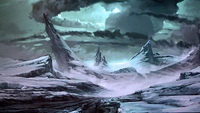
The frozen tundra of the South Pole.
A significant stretch of tundra covers most of the South Pole. In contrast to the mountainous landscape of the North Pole, the frozen plains of the South are broken only occasionally by mountains. The harsh terrain was made all the more dangerous by a brutal, unending storm that had battered the South for decades. Known as the Everstorm, this spiritually-charged blizzard rendered the land uninhabitable. Dark spirits were known to haunt the tundra's ice caves.
Within the tundra lies a great frozen forest where many dark spirits reside. In the center of this sacred forest is a portal to the Spirit World, which is only accessible by the Avatar on a solstice. It is also the source of the southern lights.[13]
Customs
Ice dodging
- Main article: Ice dodging
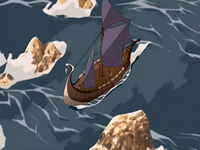
Ice dodging in Earth Kingdom waters.
The tribe has a unique rite of passage called ice dodging. This is a coming-of-age ritual that serves as a young boy's first step toward being realized as a true warrior. The rite is described as a ceremonial test of wisdom, bravery and trust.
When a boy reaches the age of fourteen, his father takes him out to sea and challenges him to guide the boat through iceberg-studded waters. The father watches, but does not interfere. If and when the boy succeeds, his father places a ceremonial mark on his forehead symbolizing the virtue he demonstrated most prominently during the test. The Mark of the Wise is awarded to those who show leadership and decisiveness. The Mark of the Brave is given for inspirational displays of courage. Finally, the Mark of the Trusted is bestowed upon those who prove themselves to be exceptionally steady and dependable.
The Southern Water Tribe is willing to adapt traditions such as ice dodging when circumstances warrant it. When Bato realized that Sokka had never undergone the ritual due to Hakoda's departure, he took Sokka, Katara, and Aang on an ice dodging expedition in rocky Earth Kingdom waters. When they succeeded, he marked all three and declared even Aang an honorary member of the Water Tribe.[20]
Games
Children of the Tribe play a game called penguin sledding, which consists of catching an otter penguin and riding its back as a makeshift sled.[19] One typically lures in the otter penguin with a fish to make catching it easier.
Gender equality
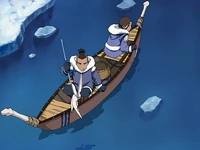
Spear fishing.
While the Northern Water Tribe is an exceptionally strict patriarchal culture, gender roles in the Southern Water Tribe are far less rigid. Katara was shocked to learn that the Northern Tribe forbade women from learning waterbending apart for healing purposes, seeing how her father, Hakoda, recognized her bending abilities early on and unsuccessfully sought a master to teach her.[21] Female waterbenders took an active part in battle,[9] and are never forced into arranged marriages, but are instead free to marry whomever they see fit.
Nevertheless, the Southern Tribe does not seem to be entirely free of gender roles. During the first few episodes of the series, up until his encounter with the Kyoshi Warriors, Sokka displayed a sexist attitude, claiming on numerous occasions that men are naturally better than women at tasks like hunting, fishing, and combat.[22] In addition, during the siblings' childhood, Katara was responsible for "women's work" like midwifery and washing and mending clothes, including Sokka's; in contrast, Sokka was allowed to spend his time building fortifications and training younger boys to defend the village against the Fire Nation, despite the fact that his preparations were inadequate to deal with any real attack. However, notably, even Sokka was shocked and confused to learn of the Northern Water Tribe's sexist customs. In general, the Southern Water Tribe seems to have a simpler, less hierarchical culture and a more open-minded and flexible mindset.
Buildings
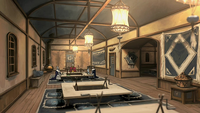
The post-war architecture of the Southern Water Tribe is much more grandiose in design than earlier styles.
In 99 AG, most of the residents in Sokka and Katara's village slept in tents made of sealskin.[19] However, prior to the destruction inflicted during the Fire Nation attacks, residents of the Southern Water Tribe lived in igloo-like structures.[9]
The inside of a typical Southern Water Tribe hut contained a number of animal pelts that were placed on bamboo floors. At one end of the hut, a sealskin tent would be set up for use as a sleeping chamber. Ceremonial animal headdresses, spears, and animal skins were usually displayed on the walls of the hut.[19]
In the center of the hut would be a square fire pit, surrounded by a single line of bricks. The fire provided heat for the hut, and was also used to prepare food. There were mats for sitting on all four sides of the fire pit. A stew post, used for cooking, would hang suspended from the ceiling, hovering above the fire.[23]
Warriors
Warriors of the Southern Water Tribe wield weaponry that includes clubs, scimitars, bone spears used in spear fishing, bladed boomerangs, machetes with whale teeth on the dull side of the blade, and shields. Black and white warpaint in a pattern reminiscent of a wolf is traditionally applied to the face before entering a battle.[15] During the invasion of the Fire Nation, all the warriors wore wolf-headed helmets and suits of armor.[24]
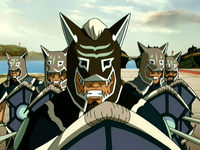
Warriors of the Southern Water Tribe.
It seems as though all adult men of the tribe are expected to be fully trained warriors. Two years prior to Avatar Aang's reawakening, all the tribe's men sailed to the Earth Kingdom to join the war effort. It is unclear whether women without waterbending abilities are ever allowed to train as warriors; however, there are very few women left behind, so the lack of women in the war party may simply reflect the tribe's overall population decline as a result of Fire Nation attacks. It is clear, however, that women who are waterbenders are accepted as fighters in the Southern Water Tribe; the northern faction's custom of restricting female waterbenders from combat takes Katara completely by surprise, and a flashback shows Hama and other women using their waterbending abilities to defend the tribe against the first Fire Nation raid.[9]
Although the tribe had grown significantly in size after the end of the Hundred Year War, by 171 AG, it still lacked manpower and organization when compared to the Northern forces.[5]
Natural resources and foods
Inhabiting frozen poles near the seas, the Water Tribes inherently are dependent on the oceans for a majority of their natural resources and well as the bounty of the frozen tundra. Sea prunes are a particular favorite. Squid and seaweed can be used to make a wide variety of dishes, including soup, seasoning, and even bread and cookies.
Skins from seals are used to create tents, while pelts from polar bears and other furry animals are used for clothing and as covering for barren surfaces. Naturally, hunters and fishermen of the Water Tribes are some of the best in the world in their field.
In Republic City, authentic Southern Water Tribe cuisine can be found at the renowned restaurant, Narook's Seaweed Noodlery.[25]